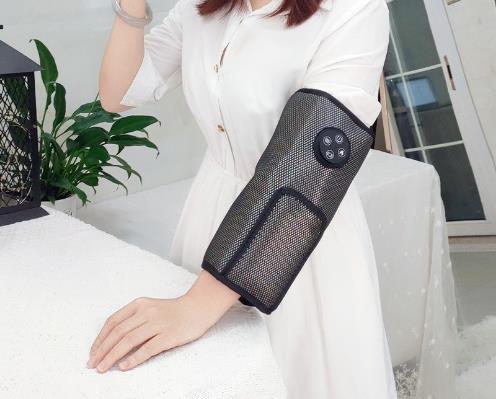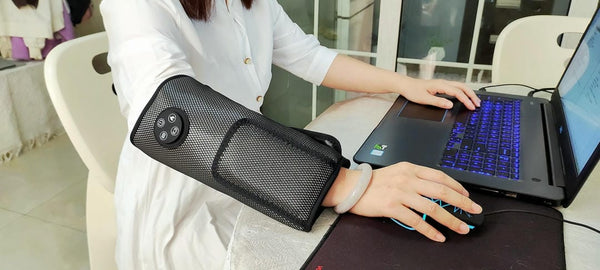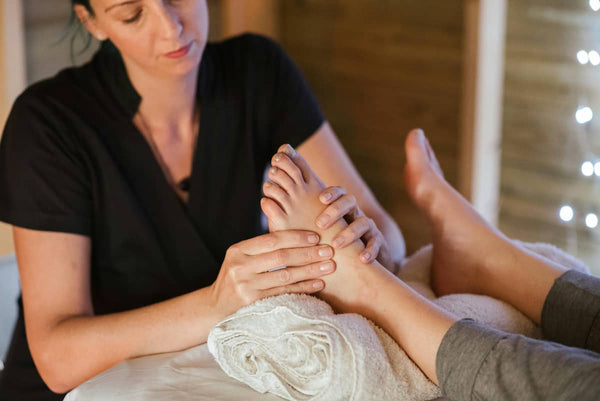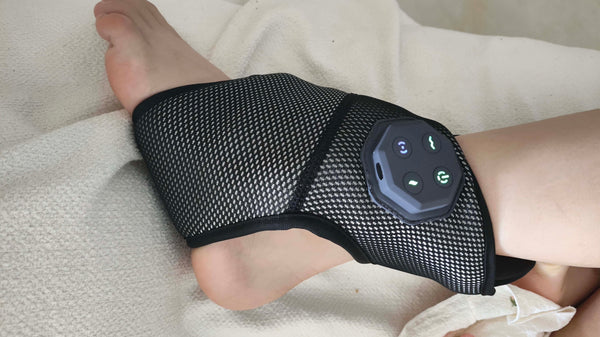
The debate around foot massagers for diabetic patients often boils down to safety: can these devices truly offer relief without causing harm? While conventional foot massagers may pose risks due to uncontrolled heat or pressure, specialized foot massagers for diabetics are designed with sensitive needs in mind. As your rehabilitation physiotherapist, I believe that with the right knowledge and doctor's guidance, these tools can be a valuable auxiliary part of daily care for anyone considering a foot massager.
Why Foot Massagers for Diabetics Need Smart Tech? Unpacking Temperature & Pressure
As a physiotherapist, I've seen firsthand the delicate balance involved in managing diabetic foot health. One common concern is neuropathy, where nerve sensitivity can decrease, making it hard to feel extreme temperatures or pressures. This is precisely why ordinary foot massagers can be problematic. Imagine a lovely warm massage turning into a low-temperature scalding injury because you couldn't feel the heat rising above 40℃! Not so relaxing, right? This is a key reason why any foot massager used by diabetics must be carefully selected. We want to bring comfort, not create new problems. It's like trying to navigate a dark room without a flashlight – you need the right tools to stay safe and comfortable, especially if you're looking for the best foot massager for neuropathy.
This is where smart technology in a specialized foot massager for diabetics truly shines. These aren't your grandpa's vibrating footrests! Professional foot massagers come equipped with precise temperature control, offering settings that keep the heat within safe limits – typically below 40℃, a crucial safety threshold for sensitive skin. This precise control avoids the 'hot spots' that can develop in less sophisticated devices. They also feature overheat protection, which is an invaluable safeguard, automatically shutting down if the temperature exceeds a safe level. Furthermore, many models incorporate an automatic shutdown function after 15 minutes. This isn't just a convenient timer; it’s a fundamental feature to prevent prolonged exposure that could otherwise lead to low-temperature scalding, something often overlooked in general-purpose devices. It’s like having a tiny, vigilant guardian for your feet, ensuring a safe and beneficial experience without you having to constantly monitor it. This makes it a truly effective foot massager for diabetics.
Beyond temperature, pressure is another biggie that many overlook when considering a foot massager. An ordinary foot massager might apply mechanical squeezing that could accidentally hurt a delicate, ulcerated area – a big no-no for diabetic feet, which are already prone to slow healing and infection. Such mechanical pressure can easily exacerbate existing issues or even create new ones. The best foot massager for neuropathy, however, often adopts advanced air pressure regulation technology. This isn't just about comfort; it's about dynamic fitting to different ankle shapes, ensuring a gentle, yet effective, massage without excessive local pressure that could lead to secondary injuries. This adaptive technology truly sets a specialized foot massager apart, making it a viable option for those with delicate foot conditions. My personal experence working with patients confirms the profound value of this feature when choosing a foot massager, especially for long-term use. It’s about creating a soothing sensation that promotes circulation, rather than a forceful one that risks tissue damage. This kind of thoughtful design is essential for any foot massager for diabetics.
- Temperature Control: Always prioritize a foot massager with precise, multi-level temperature adjustments (e.g., three-level settings are ideal) and robust safety features like overheat protection and auto-shutoff after a set duration, typically 15 minutes. These are not just bells and whistles; they are essential for your safety.
- Pressure Regulation: Opt for models that use air pressure technology over mechanical rollers. This ensures a uniform, gentle massage that adapts to your foot's contours, avoiding dangerous localized squeezing that mechanical rollers might cause. It’s a delicate hug for your feet, not a squeeze.
- Material Matters: The device's material is often overlooked, but it's critically important. Quality materials like imported diving fabric, known for its breathable and moisture-permeable properties, significantly reduce the risk of dirt accumulation and bacterial growth. This is paramount for diabetic skin, which is more susceptible to infections. Inferior materials are simply a breeding ground for germs, posing a serious infection risk for sensitive diabetic skin.
- Multi-functional Design: Consider multi-functional foot massagers, such as the Klcosy model mentioned by users. These often offer combined massage modes (e.g., kneading, rolling, compression) and multiple pressure settings, providing comprehensive care tailored to diverse needs. This thoughtful design minimizes the risks associated with single-function, less adaptable units, making your foot massager investment truly worth it. It’s about getting the most beneficial and safest experience possible.
Frankly, thinking about a simple vibration pad for sensitive diabetic feet gives me the shivers. The right foot massager is less about brute force and more about intelligent, gentle care. It's not just a luxury; it's a strategic move for daily foot health, aiming to boost circulation and comfort safely. This proactive approach can potentially reduce the incidence of more severe complications down the line. Actually, the impact of proper circulation for diabetic patients cannot be overstated; it's vital for preventing complications and maintaining overall foot integrity. For more in-depth information on diabetic foot care, you can refer to Diabetic Foot Care Guidelines. Remember, healthy feet are happy feet, and the right foot massager can contribute significantly to that happiness, helping you stay mobile and independent.
Consulting Your Doctor: A Prudent Step Before Using a Foot Massager for Neuropathy

While I’m excited about the advancements in specialized foot massagers for diabetics, I must emphasize a crucial point: these devices are powerful tools, but they aren't magic wands. Before you even think about purchasing the best foot massager for neuropathy, a chat with your doctor or a podiatrist is absolutely non-negotiable. Why? Because every diabetic patient's condition is unique, influenced by the severity of their diabetes, the presence of complications like neuropathy or vascular disease, and their overall health profile. What's safe and beneficial for one might not be for another. It's an imporant step to ensure your well-being with any foot massager, especially given the complexities and vulnerabilities of diabetic foot health. Think of your doctor as your personal foot-health compass, guiding you safely, particularly concerning the use of a foot massager for neuropathy.
As a physiotherapist, I often tell my patients, "Think of a dedicated foot massager as an excellent co-pilot, not the main pilot." They can certainly enhance daily care, potentially improve circulation, reduce swelling, and offer soothing relief from common aches and pains. However, they are never a replacement for professional medical treatment, regular check-ups, prescribed therapies, or the comprehensive care plan your doctor has developed for you. This distinction is absolutely vital for managing your condition effectively and preventing serious complications. If you have active foot ulcers, acute infections (like cellulitis), severe peripheral neuropathy (where sensation is completely absent), or any other significant foot complications such as Charcot foot, using a foot massager—even a specialized one—could very easily worsen your condition and significantly delay proper healing. Your doctor can assess your specific situation, review your medical history, and provide personalized advice on suitability for a foot massager, taking into account all aspects of your health and current treatment plan.
It's about screening criteria, really. Are there any open wounds, cuts, or blisters on your feet? Is there any severe swelling, redness, or signs of active infection? Has your doctor already advised against foot baths or massages due to specific underlying conditions like uncontrolled blood clots (e.g., deep vein thrombosis) or severe vascular disease? These are critical questions to ask yourself and your healthcare provider before introducing a foot massager into your routine. For instance, if you have acute DVT, a massage, regardless of how gentle or sophisticated the foot massager, could potentially dislodge a clot – a life-threatening situation. So, while the idea of a soothing foot massage sounds lovely and appealing, prudence is your best friend here. Don't just dive in headfirst based on online reviews; get that green light from your healthcare team before bringing a foot massager into your routine. They can guide you on the safest way to incorporate such devices and ensure they complement, rather than contradict, your medical management.
Is Foot Massage Good for Diabetics? We Tackle Your Concerns.
Now, let's address those burning questions that often pop up in my clinic, especially from middle-aged and elderly individuals keen on maintaining their health. Many of my patients ask, "Is foot massage good for diabetics?" My answer is usually, "It can be, but with significant caveats and the right equipment!" A gentle, properly designed foot massager can indeed help improve blood flow, reduce muscle tension, and provide comfort, which can be incredibly beneficial for individuals experiencing foot discomfort, fatigue, or mild neuropathy related to diabetes. This can lead to a better quality of life and improved daily mobility. However, without the advanced safety features discussed earlier, risks far outweigh potential benefits from any type of foot massager. Always prioritize safety over convenience; a well-intentioned but unsafe device can do more harm than good, even for someone who might otherwise benefit from a foot massager for diabetics.
Next up: "Can diabetics use foot massagers?" Absolutely, many can! But here's the kicker: it must be a diabetic-specific foot massager, not just any old device lying around that you might pick up on a whim. These specialized units are engineered with the unique challenges of diabetic feet in mind, such as reduced sensation, increased susceptibility to injury, and slower healing times. They prioritize crucial features like precise temperature control (to prevent burns), gentle air pressure (to avoid tissue damage), and hygienic, safe materials (to minimize infection risk). It's about choosing wisely and, critically, consulting with a healthcare professional first before you use a foot massager. Think of it as a personalized prescription for comfort and care, tailored to your unique health profile, ensuring it's the best foot massager for neuropathy for you.
Finally, the crucial query: "Who should not use a foot massager?" This is vital information for everyone, and it's a point I strongly emphasize in my practice. Individuals with active foot ulcers, acute infections (like cellulitis, a bacterial skin infection), severe peripheral artery disease (PAD) where blood flow is significantly compromised, or deep vein thrombosis (DVT) should strictly avoid using any foot massager. Massaging could dislodge blood clots or worsen an infection, leading to very serious complications. Additionally, if you have severe neuropathy where you cannot feel pressure or temperature at all, the risk of injury from a foot massager is simply too high, as you might not detect problems like blisters, bruises, or burns until it's too late. Always err on the side of caution; your feet are too precious, and protecting them from harm is our top priority as healthcare professionals. When in doubt, consult your doctor!
Taking care of your feet is paramount when living with diabetes. While the right foot massager can be a beneficial addition to your daily routine, remember it’s part of a larger, comprehensive foot care strategy that includes regular check-ups, proper footwear, and diligent self-inspection. Ready to explore safe options or just want to ensure your current foot care routine is top-notch? Don’t wait for problems to arise; be proactive in your foot health journey. Your feet will thank you, and a proactive approach will keep you stepping forward confidently, enjoying life with greater comfort and safety!




0 comments